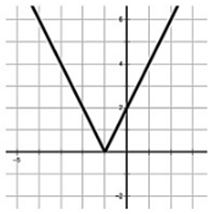FIND DOMAIN AND RANGE OF ABSOLUTE VALUE FUNCTION FROM GRAPH
What is domain from graph ?
The horizontal spread or the spreading over the x-axis is knowns as domain.
The vertical spread or the spreading over the y-axis is knowns as range.
For absolute value function, which is in the form of
y = a |x-h| + k
the domain will be all real values.
For example, considering the graph given below.

Domain :
The horizontal spread of the graph, or the spreading over all the x-axis. So, domain is {-∞, ∞}.
Range :
The vertical spread of the graph, or the spreading is above 0 on y-axis. So, range is {0, ∞}.
From each graph :
(i) Find vertex and write a function
(ii) State the domain and range
(iii) Intercept
(iv) axis of symmetry
Problem 1 :

Solution :
Equation of the function :
General form of absolute value function is y = a|x - h| + k
Vertex is at (-1, 0), the absolute value function is passing through the point (0, 2).
Applying the vertex,
y = a|x - (-1)| + 0
y = a|x + 1|
Applying the point (0, 2), we get
2 = a |0 + 1|
2 = a
So, the required function is
f(x) = 2|x + 1|
Domain :
All real value is domain.
Range :
[0, ∞), y ≥ 0
Axis of symmetry :
x = -1
Maximum / Minimum :
Minimum
Problem 2 :

Solution :
Equation of the function :
General form of absolute value function is y = a|x - h| + k
Vertex is at (3, 1), the absolute value function is passing through the point (4,0).
Applying the vertex,
y = a|x - 3| + 1
Applying the point (4, 0), we get
0 = a |4 - 3| + 1
-1 = a
a = -1
So, the required function is
f(x) = -|x - 3| + 1
Domain:
All real value is domain.
Range:
[1,-∞), y ≤ 1
Axis of symmetry:
x = 3
Maximum / Minimum
Maximum
Recent Articles
-
Finding Range of Values Inequality Problems
May 21, 24 08:51 PM
Finding Range of Values Inequality Problems -
Solving Two Step Inequality Word Problems
May 21, 24 08:51 AM
Solving Two Step Inequality Word Problems -
Exponential Function Context and Data Modeling
May 20, 24 10:45 PM
Exponential Function Context and Data Modeling